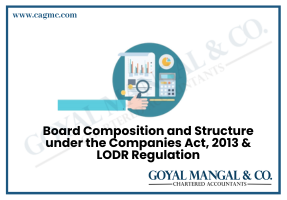 Depreciation is the reduction in the value of an asset over time due to wear and tear, obsolescence, or other factors. In accounting, depreciation is used to allocate the cost of an asset over its useful life. The Companies Act, 2013 provides guidelines for the calculation and accounting of depreciation for companies operating in India. In this article, we will explore the provisions of the Companies Act, 2013 with regard to Depreciation.
Depreciation is the reduction in the value of an asset over time due to wear and tear, obsolescence, or other factors. In accounting, depreciation is used to allocate the cost of an asset over its useful life. The Companies Act, 2013 provides guidelines for the calculation and accounting of depreciation for companies operating in India. In this article, we will explore the provisions of the Companies Act, 2013 with regard to Depreciation.
Short Glimpse
Depreciation is a significant concept in accounting, and it plays a crucial role in determining a company’s profitability. It is an essential aspect of the company’s financial statements, and the Companies Act, 2013, lays down the rules and regulations governing the calculation of depreciation. Depreciation is defined as the decrease in the value of an asset due to its wear and tear, obsolescence, or usage. It is calculated based on the asset’s useful life, which is the period during which the asset can be utilized for generating revenue.
Meaning of Depreciation as per Companies Act, 2013
Depreciation is a measure of the loss in value of a depreciable asset resulting from use, the passage of time, or obsolescence, either due to technological or market changes. Depreciation is charged proportionately to the depreciable amount in each accounting period over the expected useful life of the asset. Since everything loses value over time, we can consider depreciation an expense because it benefits the company that owns the depreciating asset. Depreciation charged to depreciable assets can be booked as an expense in the profit and loss statement.
Depreciation charged as an expense on the income statement helps the company offset the loss in value of depreciable assets. Depreciable assets are assets that are used for business purposes and can be depreciated. This means that the value of the asset is treated as a business expense over the life of the asset. A company can depreciate most tangible assets, such as buildings, machinery, vehicles, furniture and fixtures, computers and equipment, and intangible assets, such as patents, copyrights, and computer software.
Reasons why Depreciation is charged?
Depreciation is often a difficult concept in accounting because it does not represent actual cash flow. The purpose of depreciation is to charge to the profit and loss account the part of an asset that relates to the income generated by that asset, which is called the matching principle, where both income and expenses appear in the profit and loss account in the same accounting period, which provides the best overview of how well a company has performed in a given accounting period.
The problem with this matching concept is that there is an immaterial connection between income generation and a particular asset. All the company’s assets should be treated as one profit-generating system; therefore, there is no way to link a specific long-term asset to a specific return. A business concern ceases to depreciate business assets when:
- The Business concern disposes of the property or
- If the Business asset has reached the end of its useful life.
If we didn’t charge for depreciation, we would have to write off all business property as an expense as soon as we bought it. This would lead to large losses in the months when the transaction occurs and, subsequently, unusually high profitability in those periods when a corresponding amount of revenue is booked, net of compensation costs. A company that does not use depreciation will therefore have extremely variable financial results.
Types of Depreciation as per Companies Act, 2013
Depreciation is calculated annually according to the methods specified in the statute. The Companies Act prescribes two methods for calculating depreciation.
- Straight-line Method: Under the straight-line method, depreciation is calculated by dividing the cost of the asset by its estimated useful life. For example, if a company purchases a machine for Rs. 1,00,000 with an estimated useful life of 5 years, the annual depreciation would be Rs. 20,000 (Rs. 1,00,000/5 years). This amount is then spread equally over the useful life of the asset.
- Written-down Value Method: The written-down value method is based on the principle that the asset’s value decreases more in the initial years of its useful life and less in the later years. Under this method, the depreciation is calculated by applying a fixed percentage to the asset’s written-down value. The written-down value is the original cost of the asset minus the accumulated depreciation. For example, if a company purchases a machine for Rs. 1,00,000 and the depreciation rate is 20%, the depreciation for the first year would be Rs. 20,000 (20% of Rs. 1,00,000). The written-down value at the end of the first year would be Rs. 80,000 (Rs. 1,00,000 – Rs. 20,000). The depreciation for the second year would be calculated as 20% of Rs. 80,000, which is Rs. 16,000. This amount is then spread over the useful life of the asset.
According to the Income Tax Act, of 1961, depreciation is to be calculated as per asset block criteria under the WDV method. The Indian Companies Act, 2013 specifies the life of various classes of assets in Schedule II as the basis for determining the rate of depreciation using the SLM, WDV, or unit of production (UOP) method. The chosen method of depreciation affects both the profit and the book value of the company’s assets.
How to use the Depreciation Calculator?
We will understand this with the help of an example.
For example, XYZ Private Limited spent 60,000 on a computer on April 1, 2021. On March 31, 2022, they seek to examine the depreciation rate for the 2021–2022 fiscal year. The percentage of the resale value is set at 5%. According to the depreciation schedule, the desktop has a three-year life cycle.
- Step 1: Adjust the investment purchase to 4/1/2021.
- Step 2: Enter 60,000 as the asset price.
- Step 3: Put 5 in the salvage/residual space.
- Step 4: Limit the asset lifetime to 3.
- Step 5: Select WDV or SLM as the depreciation method from the menu list.
- Step 6: Select Calculate from the drop-down menu.
Important notes while using the Depreciation Calculator
One should keep the following points in mind while using the Depreciation Calculator:
- Date of purchase of assets: Enter the date in dd/mm/yyyy format. The calculator does not support other date formats.
- Cost of assets: If you have claimed input tax credit on the asset, enter the price of the asset excluding the GST part. Enter the price of the asset, including the GST part, if you have not claimed input tax credit on the asset.
- Residual value: The residual value percentage is usually 5%. Enter only 5 in the calculator. If the residual value is different for your company, enter only the number without the percent sign (%).
- The useful life of the asset: For the asset, you have purchased, see the Companies Act 2013 depreciation table given in this article.
- Selection of the depreciation method: SLM: If you select SLM, the depreciation amount is calculated according to the SLM formula, and a graph is generated.
Depreciation Rates under the Companies Act, 2013
The Companies Act, 2013 provides depreciation rates for different categories of assets. The rates are as follows:
- Building: 2.5%
- Plant and Machinery: 7.5% to 20%
- Furniture and Fittings: 10%
- Computer and Computer Software: 16.21%
- Vehicles: 13.91% to 25%
- Goodwill: No depreciation is allowed.
- Intangible Assets: No depreciation is allowed.
The above rates are minimum rates, and companies can choose to use higher rates if they wish. However, the rates cannot exceed the rates specified under the Income Tax Act, of 1961.
Other Factors for Depreciation as per Companies Act, 2013
Whenever the time shown in the schedules differs from the time that the company uses to calculate depreciation and the depreciation methodology that the business uses, this report must be included in the financial accounts, as well as the life of the property that companies use to calculate depreciation. Godowns, work areas, and accommodations for workers are not included in industrial plants.
Depreciation of these holdings depends on pro-rata reasons immediately preceding the date of acquisition, or in the case of a sale, decommissioning, destruction, or collapse, the date may be up to the date of exclusion, sale, destruction, or dismantling. in any financial year, whenever any property is altered, disposed of, dismantled, sold, or destroyed.
In addition, the useful life specified in Part C of the plan applies to each property and in circumstances where the prices of a particular part of the property are significant to the total value of the property and its useful life differs from the actual use of such other assets. The functional life of each component that is important to the company must be calculated separately and appropriately.
Conclusion
Depreciation is a crucial aspect of accounting for companies as it affects the valuation of assets on the balance sheet. The Companies Act, 2013 provides guidelines for the calculation and accounting of depreciation, which companies must follow. The Act provides two methods for calculating depreciation, namely the straight-line method and the written-down value method. It also provides minimum depreciation rates for different categories of assets. Companies must ensure that they comply with the provisions of the Act while calculating depreciation.







